Pros
Cons
Testing / Performance
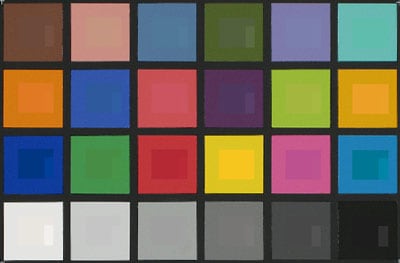
From that view, colors look very accurate. To get a better idea of which colors are the most accurate, Imatest output the chart below. It shows the chart’s ideal colors as squares and the G7’s colors as circles. The line between the two shapes shows the degree of error, although this line isn’t seen often on this chart because the colors are so accurate.

Indeed, the most erroneous colors are blue. This is a twist: many compact digital cameras have the most error in the warmer end of the color spectrum to enhance Caucasian skin tones in portraits. The Canon G7 however, performed more like Canon's DSLRs, keeping most of its colors right where they should be with a mean color error of only 5.53. This is an extremely good score and is helped even more by the ideal saturation of the colors. The G7 oversaturated colors by only 2.4 percent. With its accurate and realistic reproduction of colors, the Canon PowerShot G7 ranks among the best compacts we've tested, earning an overall score of 10.85.
**Still Life Sequences
***Click on any of the thumbnails below to view the full resolution images.
*
Resolution ***(8.09)*
**The Canon PowerShot G7, tied with the PowerShot A640 in the compact digital camera "megapixel race," has a whopping 10 megapixels. We tested the quality of the camera’s 1/1.8-inch CCD by photographing an industry standard resolution chart and loading the images into Imatest software. We tested the camera at different focal lengths and apertures and report the sharpest shot the camera produced, which was taken at 22mm with an aperture of f/4.0.
[**
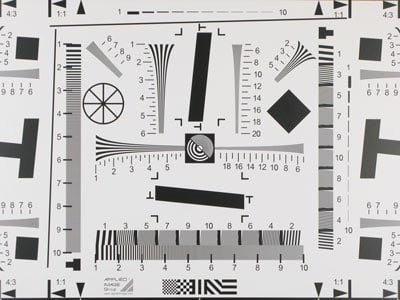
**](https://www.reviewed.com/cameras/viewer.php?picture=G7-resolution-lg.jpg)
Click to view high-resolution image
The 10-megapixel image above shows a sharp center but slightly blurry corners. The black triangles in the corners are a lighter shade than those in the center on the image, although they are all completely black on the original resolution chart hanging on the wall of our office. This discoloration is a bit disappointing, but the Canon G7 still captured quite a bit of detail.
Imatest determines how sharp an image is in terms of line widths per picture height (lw/ph). This measurement indicates how many black and white lines of equal thickness could theoretically cram across the image without blurring together. The G7 could fit 1903 lw/ph horizontally with 4.8 percent oversharpening and 1695 lw/ph vertically with 13.9 percent undersharpening. This is quite impressive, as it should be for a camera that advertises 10 megapixels. The cheaper PowerShot A640 also advertises 10 megapixels and produces similar results, although it does so by applying more in-camera sharpening, which could cause artifacts and present problems when enlarging prints or editing the image on a computer. Between the two models, the G7 produces sharper images.
**Noise – Auto ISO ***(1.99) *
After activating the automatic ISO setting, we tested the camera in optimal light to see how it would react. Many cameras choose a low ISO setting in this test, which the G7 did. However, even its low settings have at least 1 percent of the image speckled with noise. For this, the G7 received a disappointing 1.99 overall auto ISO noise score.
**Noise – Manual ISO ***(5.06) *
The Canon PowerShot G7 has an expansive manual ISO range, but it comes with a price. The higher the ISO sensitivity, the more noise will creep in the picture. Below is a chart that shows just how much noise (vertical axis) appears at each ISO setting (horizontal axis).

In terms of noise, the G7 performed much more like a compact camera - with a lot of pixels crammed on a small sensor - than a potential DSLR substitute. At the lowest ISO 80 setting, about 1 percent of the image consists of noise. This steadily climbs through ISO 400, then jumps way up. At ISO 800, about 2.5 percent of the image is speckled with noise and at ISO 1600 more than 5 percent of the image is lost to noise. Although there is less noise here than on the Canon A640, this still isn’t as clean as it should be.
**Low Light ***(7.98) *
We tested the Canon G7 in less perfect lighting by dimming our studio lights to 60, 30, 15, and 5 lux. The first two tests are done in fairly common lighting situations for most photographers. The latter two are dark enough that it sometimes takes some searching to find the shutter release; they are still useful in that these very dim tests illustrate the threshold and limitations of the imaging sensor.
Images remained illuminated and properly colored throughout the tests. Even at the dimmest 5 lux, the Canon G7 had a mean color error of 7.9. This is using the ISO 1600 setting. Compare that to the mean color error of 5.5 in perfect lighting with the low ISO 80 setting - not bad at all. The pictures are nicely colored and illuminated, but noise is visible across the frame.
There was some noise in optimal lighting, and noise is typically worse in darker situations. We tested this hypothesis and were surprised by the results. The longer the shutter was open, the less noise there was. Check out the following chart. It shows shutter speeds from 1-15 seconds on the horizontal plane and the accompanying noise on the vertical plane.
**

**
Most cameras show a steady slope upward, but the G7 shows a jagged line heading downward. It seems that the G7's long exposure noise reduction gets stronger as the exposure is prolonged. Of note, however, is the shutter speed range that isn’t as extensive as most cameras of this caliber. The Canon G7 slows to only 15 seconds whereas other models geared for enthusiasts top off at 30 or 60 seconds.
Despite the relatively short shutter speed range and presence of noise with the ISO 1600 setting, the Canon PowerShot G7 still delivered one of the best low light performances of a compact digital camera with the overall 7.98 score.
Dynamic Range ***(4.94)*
**To test how many shades of light to dark the camera can capture in one shot, we turned off the lights and backlit a film step chart that shows a series of rectangles ranging from transparent to black. The rectangles represent 13 exposure steps, which is more than what any digital camera can capture in a shot. We snapped pictures of the chart and uploaded them to Imatest, which determined how many exposure steps the G7 could capture at each ISO setting. As the ISO is increased, most cameras lose detail.
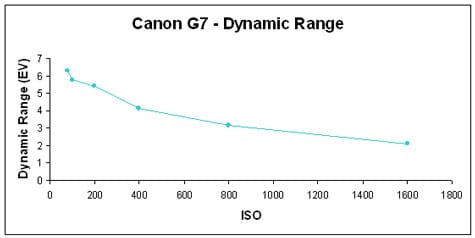
Indeed, the Canon PowerShot G7 lost a lot of detail and dynamic range as the ISO was increased. At its best, it captured a bit over 6 exposure steps. After ISO 200, the dynamic range plunged. At ISO 1600, only 2 exposure steps were captured. This is in optimal conditions too, so pictures may be quite dreary and lifeless at ISO 1600. The Canon PowerShot G7 did not perform well at all in terms of its dynamic range.
Speed/Timing
*Startup to First Shot (8.1)
*The Canon G7 took 1.9 seconds to power up and snap its first picture. It is always recommended that photographers anticipate the action and have cameras powered up beforehand because sometimes 1.9 seconds, although decent, is not fast enough to capture that perfect picture.
Shot-to-Shot (9.5)
In the Continuous mode the G7 took shots every 0.5 seconds and continued indefinitely. In Continuous AF mode the camera attempted to autofocus between shots and took pictures every 1.3 seconds until the card filled up. The Canon G7’s burst mode isn’t incredibly fast – it certainly won’t replace a DSLR – but it is decent for a compact model and its ability to continue to the memory card’s capacity is quite impressive.
Shutter-to-shot (9.0)
The auto focus isn’t DSLR-quality, so it takes the camera 0.6 seconds from the moment the shutter release is pressed to the moment the picture is taken in many cases. If the G7’s exposure and focus are already locked (the shutter is already pushed halfway down), then the shutter lag is only a few hundredths of a second.
Processing (8.2)
The G7 takes about 0.9 seconds to process one shot in all modes.
Physical Tour
**Front ***(8.25)*The front face of the Canon PowerShot G7 has a cool retro design with a matte black finish and chrome serrated rim around the base of the lens. Within the chrome ring, the lens barrel protrudes in two segments and has specs printed around the innermost rim: "Canon Zoom Lens 6x IS, 7.4-44.4mm, 1:2.8-4.8." In the center is the actual glass that is rectangular and covered by plastic petals that snap on and off. To the lower right of the lens is the ring release button that can be pushed while twisting the chrome serrated ring around the lens. This comes off to show an edge that accepts conversion lenses. To the lower left of the lens is a G7 logo embossed into the body. To the upper right of the lens is a chrome Canon logo with the built-in flash unit just above it. Above the lens is the optical viewfinder that is nearly square-shaped and protrudes just slightly. To the upper left of the lens is a large circular auto focus assist lamp that doubles as the self-timer. The left side of the Canon G7 sticks out more than the rest of the flattened body, although it’s barely noticeable. At the cusp of the tiny grip is a vertical strip of rubber meant to provide traction for the fingers.
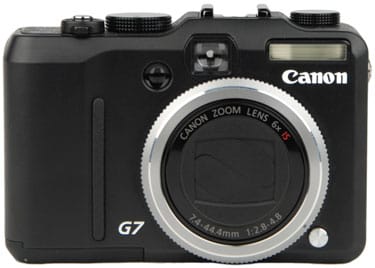
**
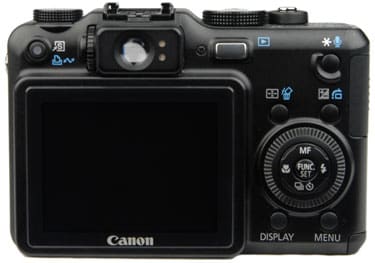
Back***(8.5)*This side contains most of the camera’s controls and is what users will likely stare at often. The 2.5-inch LCD screen is located in the lower left corner of the back. It has a Canon logo near the bottom and an anti-reflection coating that makes it appear almost purple in color when turned off. The LCD is raised on a tiny platform along with the optical viewfinder just above its center. The viewfinder has a circular opening for the actual glass and two tiny LEDs on the right. To the left of the viewfinder’s platform is the round diopter control that is plastic and has tiny ridges on it that aren’t very comfortable. On the upper left corner of the G7’s back is a print/share button with an LED in the middle and two icons on the side designating its function.
To the right of the optical viewfinder is the chrome and rectangular playback button. This button is different from others on the back because it is chrome and not black. This is preferable because the black buttons blend too well with the matte black finish of the housing. In the upper right corner of the back is a button with a ridge the shape of an elbow noodle around the bottom and left edges. This ridge distinguishes the button from the others on the camera. The button itself accesses auto exposure/flash exposure functions along with the microphone.
To the right of the LCD screen is a whole set of controls with the navigational dial surrounded by two buttons on the top and bottom. The button at the top left selects the auto focus zone and deletes single images. The button at the top right changes the exposure compensation and activates the jump feature in the playback mode. The lower left button changes the display on the LCD screen and the button to its right makes the menu appear and disappear like magic. Between the buttons is a circular arrangement with a central Func./Set button. Around that button is a ring with multiple functions in the four cardinal directions: MF (manual focus) on top, flash on the right, burst/self-timer on the bottom, and macro on the left. The outer ring is larger than the size of a quarter and has tiny ridges on it that make it easier to rotate. This ring-shaped control makes navigation through large numbers of images simple and comfortable in the playback mode.
**Left Side ***(7.5)*The top of the left side has a chrome neck strap eyelet bolted into it. Below this is a square-shaped pattern of 16 holes that serves as the speaker.
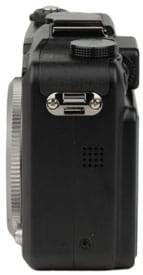
**Right Side ***(7.5)*The top of the right side also has a chrome neck strap eyelet. Below it is a door that slides toward the back when pushed down; it covers the AV and USB ports. At the very bottom of this side is a tiny black door that is hardly noticeable. It is placed just above the battery compartment door and can be pushed up so the AC adapter can fit in.
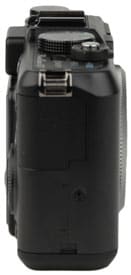
**Top ***(8.75)*The top of the G7 combines retro and modern elements. The left side has an ISO dial with its automatic and manual settings printed on it. To its right is the hot shoe, which is raised. On the right side is the mode dial with the following exposure modes: Movie, Stitch Assist, Scene, Auto, Program, (Tv) Shutter Priority, (Av) Aperture Priority, Manual, Custom 1, and Custom 2. To the right of the large mode dial is a smaller control combo with the silver shutter release button in the center and a black outer zoom ring. Behind this feature is a silver rectangular power button with a PowerShot G7 logo below it.

**Bottom ***(8.0)*
The bottom of the Canon PowerShot G7 shows off its thickness. It is thicker on the right side where the LCD screen protrudes slightly on the back, but is flat besides that. There is a metal tripod socket centered in the bottom of the camera. To the left is battery compartment that doesn’t have an outer lock on it, but can be pushed and slid outward to reveal the battery compartment and memory card slot.

Components
**

Viewfinder ***(4.0)*The Canon PowerShot G7 has a 15mm eyepoint real image optical zoom viewfinder. By "real," I guess they mean that the image is not generated by a sensor. However, the image isn’t "real" - what you see is not what you get. The viewfinder is above and to the left of the lens, so its view has a different perspective for sure. In fact, when the lens and zoom viewfinder are zoomed wide, users can see the lens in the viewfinder. Canon’s specs confirm this: the viewfinder is only 80 percent accurate.
There is a diopter adjustment to the left of the viewfinder platform that has 8 steps between -3 to +1 for users who want to shed their glasses. Despite that, the entire view isn’t very clear. The center of the view may be clear, but the outer edges of the window look blurry. Besides that, the eyecup surrounding the viewfinder isn’t very comfortable because of its hard plastic construction. Considering the 2.5-inch LCD screen, users don’t have to get up close and personal with the camera to preview images. The screen provides an accurate field of view and lets users know whether they’re in focus along with a host of other information. With the inaccurate field of view, blurred edges, and plastic construction of the optical viewfinder, the LCD screen is a much better viewing option.
**LCD Screen ***(7.0)*
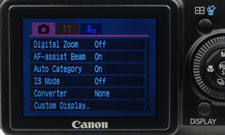
The Canon PowerShot G7 has a very different LCD monitor than the G6. The older model had a 2-inch screen that folds out and rotates much like those on the A-series cameras. Its resolution was sub-par too at 118,000 pixels. The new G7 does much better in this area with a 2.5-inch LCD screen and 207,000 pixels. The resolution is decent, but many other competitors are offering 230k pixel screens in the same size. The Canon G7’s screen does not fold out, although it does have a reasonably wide angle of view. It’s not the widest viewing angle on the market, but it’s okay. The screen doesn’t automatically gain up or down in difficult lighting, but there are 15 brightness settings in the setup menu that can be manually adjusted. The G7’s screen is normally bright indoors, but may need some adjustment outdoors on a bright day. As a viewfinder, the LCD screen is hard to beat with its nice size and 100 percent accurate field of view. The only drawback is its refresh rate, which doesn’t seem to be fast enough to smoothly depict fast-moving subjects. Display information can be changed with the designated Display button. It cycles through the following modes: off, on with info, and on with info and histogram. The following info can be displayed on-screen: mode, image size, compression, flash, drive, anti-shake warning, pictures remaining, shutter speed, aperture, ISO, white balance, and metering. The display modes can be changed in the menu and customized to show grid lines, histograms, etc. Overall, the low-temperature polycrystalline silicon LCD screen is nicely sized and its accuracy makes it a better viewing choice than the retro viewfinder.
**
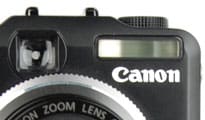
Flash ***(7.75)*The Canon PowerShot G7 has a built-in flash unit that isn’t well-placed. Its spot in the top right corner of the front of the camera makes it a prime candidate for accidental covering by the left fingertips. It will invariably cast shadows to the right of subjects. I did this several times and the resulting semi-lit pictures were not desirable. The flash reaches from 1.6-13 feet in wide and 1.6-8.2 feet in telephoto when the ISO is set to Auto. In the macro mode, the flash is effective in a narrow window from 1-1.6 feet; closer distances will cause subjects to look blown out and the flash’s coverage to look completely lopsided.
This is a decent range for a compact camera, but users can add optional flashes on the hot shoe for even more power. The hot shoe accepts Canon Speedlite flash units, including the 220EX, 430EX, and 580EX models and the HF-DC1 flash. The last flash unit, the HF-DC1, fits onto other PowerShot digital cameras and is effective to about 23 feet. Users can also purchase an optional off-camera shoe cord that tethers a flash to the G7, which allows some flexibility in its positioning.
The PowerShot G7 has a few flash modes, but even more options to supplement them. On, Off, and Auto are the regular choices. In the recording menu, users can turn off and on the red-eye reduction and slow synchro. The red-eye reduction mode didn’t use a pre-flash, but shot out the auto focus assist beam instead; its method worked in the test pictures. There are also 1st and 2nd curtain flash options and a flash exposure compensation adjustment available. The adjustment offers three levels with the built-in flash in most modes and a standard +/- 2 compensation in other modes; this works well with close-up portraits that need less illumination, avoiding the "white forehead" look. When a Speedlite flash is attached, 13 levels of adjustment are available.
The G7’s flash lights up most of the frame, but misses the bottom two corners. This won’t likely show in busy pictures but will be more noticeable when shooting simple subjects. Users who want to take pictures of their Beanie Babies to sell on an online auction will need more lighting than what is offered on the camera to make the products look half-decent.
**Zoom Lens ***(7.75)*
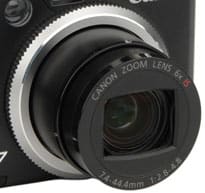
The 6x optical zoom lens extends from the camera in two segments and is surrounded by a retro-looking silver ring. The look isn’t very telling of its high-tech nature though. The lens is constructed with 9 elements in 7 groups and includes a double-sided aspherical lens and special SR coating to reduce chromatic aberrations and ghosting. This coating isn’t available on any other Canon cameras or lenses; the only other Canon product it is included on so far is the top-of-the-line professional grade camcorder.
The G7’s 6x optical zoom lens is definitely an upgrade from the G6’s 4x optical zoom lens, with an expanded focal range and the addition of optical image stabilization. The stabilization system includes Continuous, Shoot Only, and Panning modes and works very well. It is touted to correct up to three shutter speed stops, though we see it as more like two to two and a half stops. The image stabilization’s positive effects are most noticeable in the movie mode where it eliminates all the jumps and jiggles from handheld video.
The Canon 6x lens measures from 7.4-44.4 mm or 35-210 mm in the more recognizable 35 mm format. The lens’ max aperture reached f/2.8 at its widest and f/4.8 in telephoto. The telephoto’s max aperture is smaller, but not as small as many compact models’ apertures in telephoto. To keep the aperture from shrinking even more, Canon included a digital tele-converter that won’t reduce the aperture when zooming. There is also a Safety Zoom feature that digitally zooms without degrading the picture; it is only available in reduced image sizes though. Users can zoom up to 8.4x in the 2272 x 1704-pixel image size, up to 14x in the 1600 x 1200-pixel postcard size, and 24x when shooting VGA-quality photos. Standard digital zoom is available to 4x but the image quality degrades quickly.
The zoom lens is controlled by a ring that surrounds the shutter release button. It is quite small when compared with the other controls on the camera body, but still offers enough slack to zoom quickly. The Canon PowerShot G7 accepts conversion lenses. The WC-DC58B wide lens activates 0.75x magnification, while the TC-DC58C telephoto lens magnifies everything by 2x. There is also an optional LA-DC58H lens adaptor and hood set that is compatible with the G7.
Overall, the lens is decent and seems to have been given some care and consideration by Canon, though we would have liked to see the focal range start wider than 35mm, and offer a larger max aperture through the zoom range. For a 6x lens, closing down to f/4.8 will take away a lot of available light shooting opportunities and force users to boost the ISO to compensate. On the plus side, the optics appear to be very high quality, capturing very sharp pictures with hardly any distortion. The only exception to this is in the macro mode, when some barrel distortion is evident.
Design / Layout
Model Design / Appearance*(8.0)*The Canon PowerShot G7’s clean lines, beveled edges, and combination of retro and modern components give it an appealing look. The body is black with silver highlights – the most prominent being the serrated rim around the lens. The serration seems to be a theme with the edges of dials on the G7, which is great because this style is functional and makes the camera easier to grip. This is only one of several retro elements. The mode and ISO dials are a throwback to the analog days, along with the rough leather-like texture of the top panel and front grip. The body has an SLR-like profile, but it is much flatter and compact than SLRs. This design allows the Canon G7 to fit into the WP-DC11 underwater housing, which can take the camera 130 feet under water. The old-school features are complemented by new-school elements like the rotating navigational dial and the multi-selector that is more common on compact digital cameras. The Canon G7 proves a compact digital camera can still be for serious photographers, though its lack of RAW format will affect it's viability with these shooters.
**Size / Portability***(6.5)*The G7 has a similar thickness to A-series models but has much more function and substance. The camera measures 4.19 x 2.83 x 1.67 inches (106.4 x 71.9 x 42.5 mm) and has protrusions where the ISO and mode dials and hot shoe are. There is also a slightly thicker right side with a textured strip for better handling. The G7 is quite heavy at 11.3 ounces (320 g) without the card or battery. This is not a camera for one-handed shooting. The G7 is most comfortably handled with both hands and a neck strap. There are eyelets on both sides of the camera for a neck strap, but they aren’t exactly even. The right eyelet is on the top edge, while the left eyelet is clearly on the left side. The G7 doesn’t hang unevenly like some cameras, but its heft and thin strap aren’t plush either. The camera comes with a thin leather strap that isn’t very comfortable. If you plan to use the G7 for long photo shoots, invest in a better camera strap. The Canon PowerShot G7 certainly isn’t a pocket camera and despite its compact design, users will want to tote it in a camera bag to keep its hot shoe and other components as clean as possible.
**Handling Ability***(6.75)*The Canon G7 has a few good handling features, but still has a ways to go to be truly comfortable. Its hefty weight requires that users grip it with both hands. This PowerShot does have a slight protrusion for a right hand grip with a textured vertical strip on the front meant to keep fingers in place. This works fairly well, but would have been better complemented with an equally nice grip on the back for the thumb. Instead, there isn’t much support. There is a button on the top right corner of the back that has a half-circle protrusion beneath it to keep the thumb from sliding down. There is nothing to keep the thumb from sliding up though, which is more likely with the heavy body. A deep thumb divot would have been more helpful. Still, the controls’ placement makes quick grip changes possible.
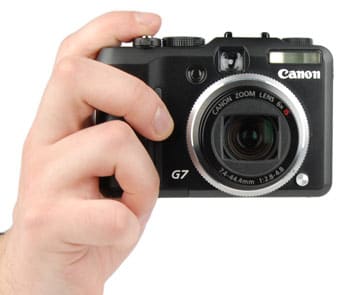
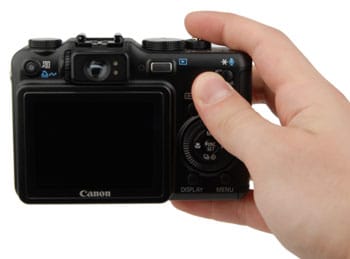
**Control Button / Dial Positioning / Size ***(8.25)*The G7 has interesting controls that include mode and ISO dials on top of the camera and more modern controls like buttons and a rotating navigation dial on the back. The controls are all nicely sized and spaced. The only exception is the shutter release button, which isn’t tiny but isn’t as large as many of the other buttons. Compared to the other controls, the all-important shutter release button looks disproportionately small. On the back of the camera are plenty of buttons that match nicely and are properly labeled, although the * button in the top right is a bit ambiguous; that symbol somehow represents the exposure lock function. The navigational control is one of the best features on this digital camera. It has a central Func./Set button that calls up a menu of frequently used settings and also makes selections within the normal menu. Surrounding this button is a traditional multi-selector ring that rocks in four directions and has icons on all sides depicting its double features. Around the multi-selector is a nicer rotating dial that can be quickly turned to navigate through menus and pictures. This takes a bit of getting used to for beginners, but you’ll be hooked once you get a feel for it. Those who appreciate the more traditional multi-selector can choose to avoid the rotating dial altogether; the multi-selector is fully functional on its own.
**Menu ***(7.25)*The Canon G7’s menu is similar to other PowerShot menus. It has a Function menu that is accessible from the center of the multi-selector; this calls up such frequently used features as the white balance and image size, among other things. It provides live views too. Its options are as follows.
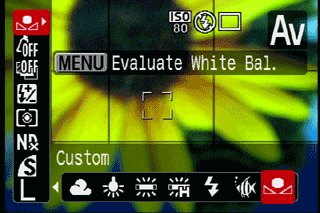
The other menu is accessed with the Menu button and is set up with three tabs at the top to organize it. The left tab is red and has an icon with a camera on it, the one in the middle is yellow with tools, and the right one is purple with a person’s head on it. This setup should be familiar to Canon PowerShot users; nothing has changed in this area. Here are the options available under the first tab.

The Setup menu provides a lengthy list of options too.

The custom menu is the same found in other Canon PowerShot digital cameras. Users can choose from three picture and sound options for the following features: startup image, startup sound, operation sound, self-timer sound, and shutter sound. The noise and pictures can also be turned off. If these options don’t satisfy an individual’s needs, more options can be loaded into the menu with the included software on the Canon Solution Disk. The software includes everything from baseballs to animals.
Alternatively, users can avoid the text menus by using the mode and ISO dials and several on-camera controls. There is even a shortcut button in the top left corner of the Canon G7’s back. This can be set to access 11 different functions from the recording menu (yes, it requires some initial dabbling in the menu).
Overall, the menus are straightforward and don’t require much fuss to set. The rotating dial makes navigation fabulous and fast. There are also on-screen directions that instruct users how to cancel out of options and return to the main menu.
**Ease of Use ***(6.75)*The Canon PowerShot G7 doesn’t have a built-in help guide, but it is fairly intuitive nonetheless and offers face detection auto focus and auto exposure. Its body may look like the A-series, which is for point-and-shooters, but it has many more options and features to wade through. The body is compact so the numerous buttons make the camera look feature-laden. The controls are well-spaced, placed, and labeled despite the number of them. Navigation is flawless with the rotating dial.
The most difficulty I had with the G7 wasn’t actually with the camera. I tried to look up a few things in the included user manual (remote shooting, for instance) and was referred from one manual to the next to the next. The G7 comes with several manuals: a basic guide, an advanced guide, and a software guide. They all refer to each other rather than citing information in each booklet. It’s a pain to find and flip through all these manuals! Besides this quirk, the G7 does a fantastic job of retaining ease of use despite its high-end classification.
Modes
**Auto Mode ***(8.75)*The Canon G7 has an Auto mode, accessible by the mode dial. It is automatic in almost every way, but allows users to adjust image size, compression, macro focus, the flash, and the self-timer. This is as simple as it gets. If users want to step it up a level, there is a Program mode that allows more access to menu options and exposure compensation. The Auto mode, however, is just as it should be: purely automatic. Also, the inclusion of face detection AE and AF will make portraits and 'people and backdrop' shots fully automated.
**Movie Mode***(7.25)*The Canon PowerShot G7’s movie mode takes great video in a variety of sizes. It has the standard options of 640 x 480 and 320 x 240 at 30 or 15 fps. In the standard size, Color Accent and Color Swap movie modes are available. The Color Accent mode highlights one color that users select by framing it in a box on the LCD, then dulling all other colors to black-and-white. Color Swap replaces one selectable color with another selectable color (More about these in the Picture Effects section). These aren’t very useful for shooting Uncle Rico’s football game, but could be used for creating home videos with plots involving little plastic people. There is also a compact 160 x 120 movie mode that records at 15 fps. Topping the list is the XGA movie mode. It has nice resolution of 1024 x 768 pixels, but its 15 fps frame rate is slow and makes everything look choppy.
The most disappointing aspect of the G7’s movie mode is that the optical zoom isn’t functional while recording. The digital zoom works, but makes subjects look horrible. Despite the dysfunctional zoom, the optical image stabilization still works wonderfully. It keeps subjects steady and takes the bounce out of video.
Users can access the ND filter and My Colors effects in the movie mode. The camera’s auto focus system works well in the movie mode, keeping subjects clearly in focus whether they’re moving side to side or toward or away from the camera.
The movie mode has a lot of audio options, although it is still monaural. Stereo audio is available on the more hybrid-oriented Canon PowerShot S3 IS The G7’s audio options include a wind filter. Users can adjust the sensitivity of the microphone too. The audio has a sampling rate of 44.100 kHz except for the compact mode’s 11.025 kHz rate. This audio isn’t as clear but emails faster.
The G7 can record movies up to an hour or 4 GB, whichever comes first. This will most likely be fine for G7 users; this isn’t exactly a hybrid model. The compact video size is the only exception: it stops shooting after 3 minutes.
Overall, the movie mode is a mixed bag. The optical zoom isn’t functional and movies don’t record longer than an hour. However, the picture looks good and the audio sounds great – so it should satisfy most point-and-shooters.
**Drive / Burst Mode ***(6.25)*The PowerShot G7’s burst mode can shoot 2 fps at the highest resolution, which is quite good for being 10 megapixels. The drive isn’t incredibly lengthy but does better than most compact models with its 6-shot burst. There is also a continuous shooting auto focus burst mode that adjusts the focus before each and every shot. This snaps away at an 0.8 fps rate. Normally, the camera can take a frame about every second until the memory card fills up. So even at its slowest, the Canon PowerShot G7 isn’t that slow. The burst mode is activated with the bottom end of the multi-selector, which also activates the self timer. It can be set to delay for 2 or 10 seconds or to the custom setting. Users can tweak the custom setting in the recording menu, where the delay can be set to 2-30 seconds for 1-10 shots.
**Playback Mode ***(7.75)*The playback mode is accessed via the designated rectangular button on the back of the camera. This makes it easy to get in and out of the playback mode easily when compared to cameras that access it via the mode dial. In the playback mode, the PowerShot G7 can display pictures individually or in index frames of nine.
Individual pictures can be magnified up to 10x and sound memos up to a minute can be added through the menu. Individual files can be deleted with the designated button. Files can also be easily erased in batches or organized by date, category, or folder. There is also an option to delete everything at once, of course.
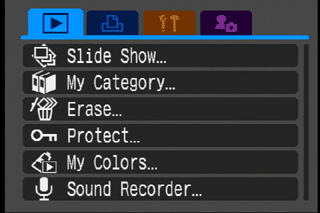
Navigation through images and the playback menu is done with the multi-selector and rotary dial. Scrolling through lots of images is easy and painless with the rotary dial; it takes only one swipe of the thumb to move through a lot of pictures rather than repeatedly pushing the multi-selector. For those who prefer the multi-selector, there is a "jump" feature that still makes navigation easy as it jumps to every 10th or 100th image or to the first file by date or folder or to movie files. Pictures can automatically rotate if the orientation sensor is activated in the setup menu. Full shooting info can be displayed along with a histogram.
There is an image tagging feature called My Category that is similar to marking pictures as "favorites" on other manufacturers’ cameras. Users can perform simple editing tasks such as cropping and rotating pictures, and video splicing. The full set of My Colors picture effects is found in the playback mode except for the custom color option. There is a slide show available along with a sound recording mode from the playback menu.
**Custom Image Presets ***(7.5)*

The Canon PowerShot G7 has more scene modes than any other G-series model. It includes a host of scene modes that are found on A- and SD-series digital cameras. The G7 has 16 scene modes: Portrait, Landscape, Night Scene, Sports, Night Snapshot, Kids & Pets, Indoor, Foliage, Snow, Beach, Fireworks, Aquarium, Underwater, ISO 3200, Color Accent, and Color Swap. The Aquarium and ISO 3200 scene modes are brand new to Canon PowerShot digital cameras. The Color Accent and Color Swap modes used to be located in the My Colors effects menu but were relocated to the scene menu in 2006. Despite the new location, the modes are the same. Users can select colors by pushing the left and right arrows on the multi-selector while framing colors with the LCD’s preview. The Color Accent mode simply highlights one color and dulls the rest to black-and-white. The Color Swap mode doesn’t flip two colors for each other but rather replaces only one color (eg. It doesn’t make red turn white and white turn red; it only makes white turn red). This isn’t incredibly useful for serious photographers, but could be good for quick pranks (e.g. e-mail a photo of your friend’s discolored car with a comment on the new "paint job"). The 16 custom image presets can be found by rotating to the "SCN" portion of the mode dial, then scrolling around with the navigational dial. Text and an icon appear with each mode, but there is no help guide to explain them. This is probably just fine, as many cameras don’t explain scene modes well anyway (e.g. "Portrait: For taking portrait photos."). On the mode dial, there is a stitch assist icon. Once there, users can choose to line up images from left to right or right to left. The G7 shows a small overlay preview on the selected side so that users can precisely reframe the next image.
Control Options
Manual Control OptionsThe Canon PowerShot G7 has a fully manual exposure mode, along with manual focus, white balance, and selection of ISO. The camera also has priority modes that limit the manual functionality but still provide access to a lot of options. If users prefer a certain set of manual controls, they can save it in the Custom 1 and 2 modes on the camera’s mode dial for easy access later. Overall, manual control options are plentiful.
**Focus***Auto Focus (8.25)
*The Canon PowerShot G7’s through-the-lens auto focus system is impressive. The camera’s Digic III image processor claims to speed things up, and it seems to have worked. The G7 is quick to focus and grab a shot. It works well too, with the pictures clearly focused. The auto focus can be set to single or continuous. The auto focus mode can be selected with the designated auto focus/delete button above the left side of the multi-selector. After it is pressed, users can scroll through the modes with the navigational dial: FlexiZone, AiAF, and Face Detection.
FlexiZone allows users to select one spot to focus on with the multi-selector. AiAF is the same 9-point system that is included on most other PowerShot digital cameras. Both systems are speedy, but the FlexiZone is faster because it doesn’t spend any time searching for subjects like the AiAF does. The AiAF isn’t a slouch; it just isn’t as fast as FlexiZone. The Face Detection is just as fast as the AiAF, amazingly, and can recognize and track up to nine faces at a time. Face detection technology is a trendy feature this year, as many other manufacturers have come out with the like.
Nikon was the first to use face detection technology in its cameras, with its Coolpix models hosting face-priority auto focus modes. Nikon’s face detection system is slow, though, and doesn’t track faces well at all. The face detection technology on the G7 and a few other recent PowerShots is the first time this technology has been available on Canon digital cameras. The system on the Canon G7 works exceptionally well. It finds faces quickly, and tracks them so fast that it almost looks like a video game. The system shows white brackets around the faces that move when subjects move. The catch is that subjects have to be facing the camera in order to be recognized; a turn of the head or some hair in the face can throw the camera off. Canon claims the system is so fast because it is run by hardware rather than software, like some other manufacturers do.
The Canon PowerShot G7 has a large auto focus assist lamp on its front to aid in low light. The lamp projects a bright green light and it can be turned on and off in the recording menu. The G7 can focus properly in low light, although it’ll take a few extra tenths of a second. The more zoomed in the lens is, the more difficult it is to focus in low light. The auto focus assist beam isn’t exactly lined up with the lens. While the assist lamp does just fine when the lens is zoomed out, its path veers farther and farther from the zoom’s vision as it is zoomed in.
*Manual Focus (4.0)
*The manual focus can be accessed from the top side of the multi-selector. Adjusting the focus is done with the large rotating dial; a vertical bar appears with distances to show the whereabouts of the camera’s focal point. The center of the image can be magnified, if that option is activated in the recording menu. Overall, manual control freaks will still prefer the zoom and focus rings of a true DSLR, but having a manual focus mode on a compact model is still a commodity. The G7 has a focus bracketing mode in the Func./Set menu that only works when the manual focus is activated. Users can snap three pictures in a burst at three different focal ranges.
**ISO***(8.0)*The Canon PowerShot G7 has an old-school ISO dial complete with automatic and manual settings. Its automatic settings include traditional Auto and a more updated High ISO Auto for shooting in low light. The old G6 had ISO sensitivity that only reached 400. Thanks to the new Digic III processor and its noise reduction technology, the G7 offers more manual ISO settings: 80, 100, 200, 400, 800, and 1600. Live views of the exposure setting are shown as users scroll through the options.
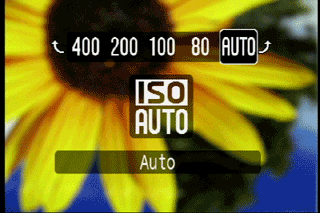
**White Balance ***(8.0)*Scrolling through the white balance options has live views too: Auto, Daylight, Cloudy, Tungsten, Fluorescent, Fluorescent H, Flash, Underwater, and Custom. The white balance menu is is accessed by pressing the Func./Set button. There are on-screen directions, which guide users through setting up the Custom white balance.

**Exposure ***(7.75)*With 25 exposure modes, the Canon PowerShot G7 has a little something for everyone. There is a full Auto mode that truly is automatic. The next level of control includes the scene modes that allow access to a few options. The Program mode offers a bit more control, followed by the Priority and Manual modes. Users can also save custom modes and settings, which are accessible by the mode dial. There is an exposure bracketing mode that lets users shoot three pictures at varying levels of exposure within the standard range. The exposure compensation scale has its own designated button and has adjustments in the +/- 2 EV range.
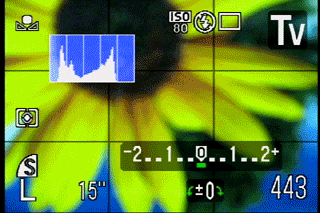
**Metering ***(7.75)*There are three metering modes available from the Func./Set menu: Evaluative, Center-weighted Average, and Spot. The Spot metering is linked to the auto focus zone, including faces when in the Face Detection auto focus mode. There is a live view when scrolling through the metering options.
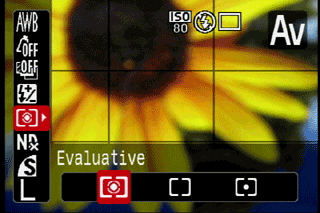
**Shutter Speed ***(7.5)*Users can scroll through the shutter speeds using the large navigational dial. The shutter can open as long as 15 seconds and flip as fast as 1/2500th of a second. The shutter speeds can be manually selected in the Manual and Shutter Priority modes, but are automatically selected otherwise. Any shutter speed longer than 1.3 seconds operates automatically with the noise reduction system.

**Aperture ***(6.75)*The high-quality 6x optical zoom lens has a maximum aperture of f/2.8 and a minimum of f/8.0. The max aperture shrinks when zoomed in on subjects, though, to f/4.8. This isn’t as small as some 3x lenses. For example, the Fujifilm FinePix F31fd’s 3x lens shrinks to f/5 in telephoto. Still, the G7’s predecessors had much wider apertures. The G6 has a 4x lens with an incredible f/2.0 aperture. You can’t find that anymore. The f/2.0 aperture allows a lot more light than the G7’s f/2.8 maximum aperture. Sure, the G7 has higher ISO sensitivity and image stabilization, but those are still no replacement for natural light. The aperture can be manually adjusted in the Manual and Aperture Priority modes. In the Manual mode, the Jump button must be used to jog between the aperture and shutter speed manual adjustments.

Image Parameters
Picture Quality**/ Size Options ***(7.5)*The image size and compression options are also available from the Func./Set menu. Superfine, Fine, and Normal options are available for the following image sizes: 3648 x 2736, 2816 x 2112, 2272 x 1704, 1600 x 1200, 640 x 480, and 3648 x 2048. The last image size listed is for shooting widescreen-optimized pictures. There is no 3:2 optimized image size for making perfectly cropped 4 x 6-inch prints. User do, however, have the option to use 3:2 guidelines that appear on the LCD screen’s display so users can crop down the images later. The 10-megapixel Canon PowerShot G7 shoots JPEG images only: it does not shoot RAW files like its G-series predecessors. Serious photographers will miss RAW shooting on the G-series; it is one of the camera’s biggest flaws and makes the G7 a little less appealing to enthusiasts.
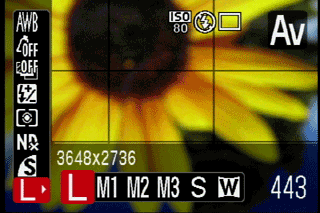
**Picture Effects Mode ***(8.5)*The Canon PowerShot G7 has a long list of picture effects: Off, Vivid, Neutral, Sepia, Black & White, Positive Film, Lighter Skin Tone, Darker Skin Tone, Vivid Blue, Vivid Green, Vivid Red, and Custom Color. This is what Canon calls its My Colors mode. This mode is available from the Func./Set menu as well as the playback menu, where live views can be seen. Users can add these effects before of after recording the image or movie.
The color can be customized with the last setting in the menu. Contrast, Sharpness, Saturation, Red, Green, Blue, and Skin Tones can all be adjusted in five levels. This My Colors mode is new to the G-series. On some previous PowerShots, the Color Accent and Color Swap modes have been included in the My Colors section of the menu. On the G7 and other more recent cameras, though, they have been positioned as separate modes in the scene menu. Basically they are just picture effects. The Color Accent mode highlights one color that users select by framing it in a box on the LCD, then dulling all other colors to black-and-white. Color Swap replaces one selectable color with another selectable color. The word "swap" is misleading though because colors aren’t swapped both ways. For instance, it isn’t possible to make a blue car turn red and a red sign turn blue in one picture. Only one or the other can happen at a time. These picture effects are neat, but they are no replacement for more flexible RAW files. Serious hobbyists will still lament the exclusion of RAW files on the G7.
Connectivity / Extras
Connectivity*Software (6.75)*The Canon PowerShot G7 comes with version 29.0 of Canon’s Solution Disk. It includes a few software programs on it for organizing and editing pictures such as ZoomBrowser EX 5.7 for Windows and ImageBrowser 5.7 for Macintosh. PhotoStitch 3.1 software stitches the panoramas made from the assist mode in the camera along with an EOS Utility program.
The utility program can acquire images from the camera, enable printing, tweak custom settings on the G7 itself (such as startup music), and activate a cool remote shooting feature. When the remote capture option is chosen, users can choose a destination folder where pictures can be saved. A smaller window shows a preview like a viewfinder and all exposure parameters, from shutter speed to white balance, can be changed on this window. The focus can be locked and unlocked and users may have to do this frequently. The zoom can be accessed as well. Once pictures are taken, they can be set to automatically pop up in the ZoomBrowser EX program behind it.
ZoomBrowser EX is the main browsing and editing program, although it is better for browsing than editing for sure. Pictures can be viewed in zoom, scroll, or preview modes with various layouts of images, file information, histograms, and comments. Users can mark favorites and add keywords to pictures that can be used for searching.
From the main window users have options to acquire pictures, view and organize files, edit, export, and print images. Pictures can be deleted or rotated from here. Editing is done in a separate window and with primitive options: trim, insert text, sharpness, color/brightness adjustment, auto adjustment, and red-eye correction.
PhotoStitch can be opened separately or accessed from the Edit portion of the main window of ZoomBrowser. It allows users to merge several pictures together automatically but doesn’t let them manually move the images.
Overall, the software included with the Canon G7 is decent but not impressive. It is good organizational software, but users may want to do more advanced editing than the program allows.
*
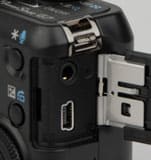
Jacks, ports, plugs (5.0)*The Canon G7 has one door on its right side that conceals two ports. There is an AV-out jack at the top and a mini-B USB jack below it. The AV-out function can be set to NTSC or PAL standard within the setup menu; it outputs monaural audio. The USB hi-speed 2.0 cable can be connected to printers or computers. The camera can accept a power adaptor, but it fits into the battery compartment and wires through a tiny door on the bottom of the G7’s right side.
*Direct Print Options (7.0)*A designated Print button is located in the top left corner of the G7’s back side. It has an LED in the center of the button and can be pushed to transfer the DPOF print orders. The print orders can be made from the playback mode. Pictures can be transferred directly to PictBridge compatible printers with the included USB cable. The Canon PowerShot G7 is Canon Direct Print and Bubble Jet Direct compliant. The camera can output index prints with 35 images on an 8.5 x 11-inch sheet or can print 20 images with shooting info. With Canon CP and Selphy printers, the camera can also print ID photos and movie prints.
*Battery (4.5)*
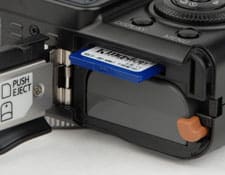
The Canon PowerShot G7 runs on a rechargeable lithium-ion battery pack NB-2LH that has a life of about 220 shots. This isn’t much at all, so users may want to tote around an extra battery. The camera doesn’t give users much warning when the battery is running low. It works perfectly up until the last moment when it shuts off and displays a message to replace the battery unit. The PowerShot G7 comes with a wall-mount charger. There is an optional ACK-DC20 AC Adapter Kit and a Car Battery Charger, which are both sold separately. *
Memory (3.0)*There is no internal memory, but the camera comes with a 32 MB SD card. This isn’t much, especially with the 10-megapixel resolution. The G7 can record video up to 4GB or 1 hour at a time. Users are encouraged to purchase a separate memory card. SD, SDHC, and MMC cards are all compatible with the G7. The memory slot is beneath the battery compartment door.
Other features ***(6.5)

My Camera Settings* – This sub-menu offers a range of sounds and images to customize your digital camera. Users can select entire themes such as birds, for example, that will display a picture of a bird while starting up and chirp when a picture is taken. The startup image, startup sound, operation sound, self-timer sound, and shutter sound can be customized. The G7 has three options and an off position for each of these. Users can connect the camera to a computer with the included software installed and open the EOS Utility window. There is an option in it to customize the camera; it is there that users can select from about two dozen themes, images, sounds, etc. and load them to the camera.
*Underwater Housing* – The first of the G-series to be compatible with an underwater housing, the PowerShot G7 can now go to depths of 40 meters/130 ft with it. The G7’s body is compact enough and flat enough to fit inside the WP-DC11 casing. Canon also sells a WW-DC1 case weight to keep the G7 from floating upwards in the water. Complementing the housing is the Underwater scene mode and the Underwater white balance preset.
*
Sound Recorder* – The PowerShot G7 has a sound recorder accessible through the playback mode menu. It can also be accessed with the button near the upper right corner of the camera’s back that has a microphone icon on it. It can record 16-bit rate mono audio at a selectable sampling rate of 11.025 kHz, 22.050 kHz, and 44.100 kHz for up to 2 hours at a time.
*Sound Memos* – A sound memo can be added to a picture just after it is taken or in the playback mode. It records at an 11.025 kHz sampling rate that isn’t crystal clear but does fine if the sound is within 3 feet or so of the camera. Memos can be up to 1 minute in length and are saved in WAVE format.
*Computer-controlled Shooting* – This is a cool feature on the G7 that allows it to double as a Web cam. It also allows users to store lots of photos directly on a computer’s hard drive rather than on the memory card. The Canon PowerShot G7 must be connected to the computer via the USB cable and the EOS Utility window must be opened. There is a remote shooting option that must be selected, then a separate window pops up with a live preview on top and exposure settings and such below it. Almost any option that can be changed on the camera can be changed in this program: shutter speed, aperture, flash, flash compensation, white balance, and ISO to name a few. One feature that is missing on the remote shooting program is the self-timer, so self-portraits will include your arm reaching for the mouse to make a click and release the shutter. Still, the computer-controlled shooting on the Canon G7 is a cool feature not included on many other compact models.
*ND Filter* – The Canon PowerShot G7 has a built-in ND filter that reduces the light intensity by up to three stops. This enables the user to shoot at slower shutter speeds and smaller apertures. This ND filter can be turned on and off in the Func./Set menu. *Optional Waterproof Housing* – The G7’s retro design is flat and compact design makes it easy to carry in a pocket. Its shape allows it to fit into optional underwater housing. The Canon WP-DC11 fits over the camera and allows it to swim to 130 feet underwater. The housing costs about $200, and the WW-DC1 case weights that keep it from floating to the water’s surface cost an extra wad of cash. The PowerShot G7 is the first of Canon’s G-series to be compatible with an underwater housing. To complement the optional housing, there are underwater scene and white balance modes.
Overall Impressions
**Value ***(6.25)*The Canon PowerShot G7 was introduced at a steep retail price of $599. The price was high because of its brand new Digic III image processor and its accompanying high ISO and face recognition technology. The newness has worn off since then. It can now be found for under $499. This is much more reasonable. Despite all of its cool features and serious functionality, the G7 is still a compact model lacking a RAW setting and should be priced as such. The G7 is likely to appeal to photographers who want a serious camera but don’t want to lug around a DSLR or invest thousands of dollars in lenses and accessories. The $499 price tag makes it an attractive option; it is similar in price to many ultra-zoom digital cameras.
**Comparisons***Canon PowerShot G6* – This digital camera looks more like an A-series camera because of its silver housing and folding LCD monitor. The older G6 has 7.1 megapixels and is much chunkier with its hand grip and 4.1 x 2.9 x 2.9-inch measurements. It also weighs 13.4 oz, so it is very heavy for its size. It has a 4x optical zoom lens that doesn’t have image stabilization, but does have a very wide f/2.0 aperture. The Canon PowerShot G6 has a 2-inch, 118,000-pixel LCD monitor that twists and swivels. It does not have face detection technology, but it does have the same 9-point auto focus setup. The G6 is equipped with manual and priority modes, but the slowest shutter speed is only 1 second. There are fewer scene modes including the three basics (landscape, portrait, night) and a stitch assist mode, as well as fewer picture effects. The G-series cameras have the same 2 fps burst mode, but the older Canon G6 records to CompactFlash memory cards rather than SD media. The G6 also shoots RAW and JPEG files, making its images more flexible for in-computer editing. The G6 has a few other differences including two custom white balance options in the menu and 14 menu languages instead of 25. Despite the new G7’s release, the older G6 has held its value at nearly the same price.
*
Nikon Coolpix P5000* – This digital camera has many similar traits to the G7, with 10 megapixels and a hot shoe on a relatively compact body. Like the Canon G7, it isn’t slim but doesn’t have a chunky SLR-shape either. The Nikon P5000 isn’t as flat as the G7 but its larger hand grip is more comfortable to hold. This Coolpix has a 3.5x optical zoom lens and an optical image stabilization system. It has a face priority auto focus system that remains unchanged from Coolpixes of yore, so it is a far cry from Canon’s superior face recognition technology. The P5000 has the same range of manual and automatic modes and a similar set of manual controls. It has a movie mode that records standard VGA and QVGA video but allows the zoom lens to function while recording – a nice perk. The P5000 is compatible with Nikon conversion lenses and Speedlight flashes, as it has a hoe shoe. An optical viewfinder and 2.5-inch, 230k pixel LCD screen are also available. Like the Canon G7, the Nikon P5000 can accept SD and SDHC cards and has a similarly disappointing 250-shot battery. It is much lighter at only 7.1 ounces and has a more powerful built-in flash that can reach 26 feet. It also retails for much less at $399.
*
Panasonic Lumix DMC-LX2* – For a retail price of $499, the Panasonic LX2 offers many of the same features as the G7. It has manual, priority, and scene modes. It has a short list of picture effects. The 10-megapixel LX2 has a 28-112mm wide 4x optical zoom lens with an image stabilization system that works just as well. A 2.8-inch LCD screen graces the back of the camera with a similar resolution of 210,000 pixels. The Panasonic Lumix model is much more compact than the G7. Both cameras are flat, but the LX2 is thinner at only an inch and is half the weight of the G7. The Panasonic Lumix DMC-LX2 comes with a wrist strap instead of a neck strap. It’s lack of a hot shoe will keep it from being an option for serious photographers. Still, it has plenty of manual controls like ISO to 3200 and 2 custom white balance settings. Perhaps the biggest difference between the LX2 and the G7 is the image sensor. Both have 10 megapixels, but they are shaped differently. The Panasonic LX2 is 16:9 formatted for recording widescreen pictures and movies natively, although it can be set to snap shots and video at standard 4:3 format. The LX2 has a better battery that gets 300 shots per charge and records to SD/MMC media.
*
Ricoh Caplio GX100* – A more recent release is the Ricoh GX100, which debuted in spring 2007. It has 10 megapixels, a 3x optical zoom lens, image stabilization, and manual controls in a compact body. The GX100’s most unique feature is its electronic viewfinder that can tilt and detach from the camera body. It looks a little strange, but it provides a much more accurate view than the G7’s. The 3x lens is shorter and wider with an equivalent 24-72mm and f/2.5 aperture. The body itself looks similar with its retro design and matte black shell. This model has a 2.5-inch LCD screen but better resolution at 230,000 pixels. It can shoot RAW and JPEG files as well as movies at the same 640 x 480 and 320 x 240-pixel resolutions and 30/15 fps frame rates. The GX100 is thinner than the Canon G7 with 4.4 x 2.3 x 1-inch measurements; it is also much lighter at only 7.8 ounces. The Ricoh Caplio GX100 can accept rechargeable batteries that get 380 shots per charge or two standard AAA batteries for only 35 shots. The GX100 has manual, priority, and scene modes along with an interesting 1:1 aspect ratio "square mode." Like the G7, the GX100 accepts SD, SDHC, and MMC media, but it also has 26MB of internal memory. It has a higher initial price tag of $699.
*
Samsung NV11* – This digital camera has a similar size, albeit a little slimmer, and a similar audience. The Samsung NV11 aims for advanced photographers who want to combine retro and modern components into a serious hip camera. The black metal NV11 has 10.1 megapixels and a 5x optical zoom lens with advanced shake reduction. This isn’t optical image stabilization but is a digital system that doesn’t work as well as Canon’s. Samsung’s LCD screen is larger at 2.7 inches with better resolution of 230,000 pixels. Perhaps the NV11’s best feature is the Smart Touch interface that surrounds the LCD screen. It consists of buttons lining the bottom and right edges of the screen. When the buttons are lightly touched, they activate certain functions on menus and navigate through images. It isn’t a touch screen but has better navigation than one. This setup certainly rivals and perhaps surpasses Canon’s rotary dial navigation; it just depends on the users’ preferences. Both cameras have better navigation than the typical multi-selectors that can tire out thumbs. The NV11 has face recognition technology that detects up to nine faces. It has full manual and priority modes along with 12 scene modes.
**Who It’s For***Point-and-Shooters -* There are simpler options on the market for cheaper prices, but the G7 appeals to these consumers with its auto and scene modes and picture effects.
*Budget Consumers -* The initial price was $599 but has since dropped a hundred dollars. $599 was too much and $499 is better. But it’s still probably not enough to draw in the coupon-cutter set.
*Gadget Freaks -* This digital camera has some nifty features that these users can show off. "Hey man, check out the sampling rate options on my G7…" or "Watch me flip through 3,000 pictures with one swipe of my thumb…" are a couple of examples.
*Manual Control Freaks* - The ideal G7 user appreciates manual controls and wants a serious digital camera, but doesn’t want to commit to an SLR and the collection of inevitable purchases that comes with it: lenses, flashes, etc. The G7 offers all kinds of manual control over exposure, but some die-hards may miss the RAW file format that was offered on previous G-series cameras.
*Pros/ Serious Hobbyists* - Pros may use the 10-megapixel G7 as a backup camera because it is so versatile and can accept accessories from Canon EOS digital SLRs like flashes.
Conclusion
**Conclusion
**When compared to other compact digital cameras, the Canon PowerShot G7 looks like a strong option. It has serious resolution at 10 megapixels, a nice 6x optical zoom lens with optical image stabilization, and its new Digic III processor allows more ISO sensitivity and trendy face recognition technology.
When the G7 is compared to its G-series predecessors however, loyal consumers will have mixed feelings. It looks better and is more portable but misses some key components, like RAW file shooting. In its place are features that cater to beginning photographers: My Colors picture effects, more scene modes, and a flatter housing that fits in an optional underwater case. With these changes, the G7 will lose some of its G-series fan base but expands its appeal to include point-and-shooters.
The Canon PowerShot G7 is designed for consumers who want the functionality of a DSLR without the bulk. The G7 has the flexibility to accept conversion lenses and a flash unit on its hot shoe, but doesn’t require those to take great pictures. In the end, the Canon G7 certainly has its flaws but still snaps crisp pictures with accurate colors.
Specs / Ratings
Specs Table
{{manufacturer_specs_table}}{{raw_scores_table}}
Photo Gallery
Sample Photos
**Sample Photos
**Click on the photos to view the full-resolution images.
Meet the tester

Emily Raymond
Editor
Emily Raymond is a valued contributor to the Reviewed.com family of sites.
Checking our work.
Our team is here to help you buy the best stuff and love what you own. Our writers, editors, and experts obsess over the products we cover to make sure you're confident and satisfied. Have a different opinion about something we recommend? Email us and we'll compare notes.
Shoot us an email